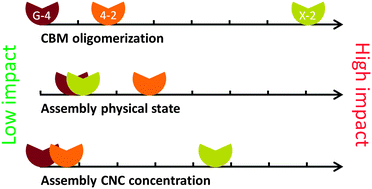Bioinspired assemblies of plant cell wall polymers unravel the affinity properties of carbohydrate-binding modules†
Abstract
Lignocellulose-acting enzymes play a central role in the biorefinery of plant biomass to make fuels, chemicals and materials. These enzymes are often appended to carbohydrate binding modules (CBMs) that promote substrate targeting. When used in plant materials, which are complex assemblies of polymers, the binding properties of CBMs can be difficult to understand and predict, thus limiting the efficiency of enzymes. In order to gain more information on the binding properties of CBMs, some bioinspired model assemblies that contain some of the polymers and covalent interactions found in the plant cell walls have been designed. The mobility of three engineered CBMs has been investigated by FRAP in these assemblies, while varying the parameters related to the polymer concentration, the physical state of assemblies and the oligomerization state of CBMs. The features controlling the mobility of the CBMs in the assemblies have been quantified and hierarchized. We demonstrate that the parameters can have additional or opposite effects on mobility, depending on the CBM tested. We also find evidence of a relationship between the mobility of CBMs and their binding strength. Overall, bioinspired assemblies are able to reveal the unique features of affinity of CBMs. In particular, the results show that oligomerization of CBMs and the presence of ferulic acid motifs in the assemblies play an important role in the binding affinity of CBMs. Thus we propose that these features should be finely tuned when CBMs are used in plant cell walls to optimise bioprocesses.


 Please wait while we load your content...
Please wait while we load your content...